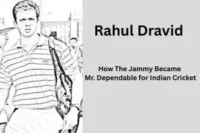Cricket DLS Method | How and When It Started, Why It’s Important
Published: 7 Feb 2025
Imagine you’re watching an exciting cricket match, and suddenly the rain starts just when things are getting intense! The match is stopped, and the chasing team hasn’t finished their innings. What happens now? How is the winner decided? This is where the cricket DLS method comes into play.
The Duckworth-Lewis-Stern (DLS) method is a mathematical formula used to recalculate the target score for the limited over matches affected by rain. It ensures a fair fighting scenario when bad weather or interruptions cut short a game.
Firstly let’s know it in simple terms so you can understand how it works!
What is the DLS Method in Cricket?
The DLS method is used to adjust the target score in a One Day International (ODI) or T20 match when rain disrupts play. It takes two key resources of the batting team into account at the point of interruption:
- Wickets left – More wickets mean the team can score more runs.
- Overs left – More overs mean more chances to score runs.
If a match gets interrupted, the DLS method calculates a new target based on how much play is lost and how many resources remain for the chasing team.
Match After Which DLS Method in Cricket Began
Before the DLS method was introduced, rain-affected matches were decided using a much simpler (and unfair) system called the “Most Productive Overs” method. Because of this, one of the most controversial moments in cricket history occurred during the 1992 Cricket World Cup semi-final between South Africa and England.
What Happened?
- England batted first and scored 252/6 in 45 overs (matches were 50 overs per side, but rain had already reduced the game to 45 overs).
- South Africa was chasing well and needed 22 runs off 13 balls when rain interrupted play again.
- After a short delay, the target was revised using the old method, which only removed the least productive overs from the calculations.
The Unfair Twist
- Because of this unfair adjustment, the new equation was that South Africa needed 22 runs off just 1 ball!
- This made the chase impossible, and England won the match.
- Fans and cricket experts were furious at how unfair the rule was.
Impact of This Match
- This controversial result played a big role in creating the Duckworth-Lewis method (now DLS), which was introduced in 1997 to make rain-affected matches fairer.
How Does the DLS Method Work?
Here’s a simple way to understand it:
- The batting team starts with 100% resources (50 overs & 10 wickets in ODIs, 20 overs & 10 wickets in T20s).
- If overs are lost due to rain, the available resources are reduced.
- The DLS method calculates how much of the total resources were used before the rain and adjusts the target accordingly.
The formula is complex, but don’t worry—you don’t need to memorize it! Cricket matches use DLS software to calculate the revised target automatically.
How DLS Method Works Fairly
One of the best examples where the DLS method ensured a fair result was the 2017 ICC Champions Trophy final between India and Pakistan.
What Happened?
- Pakistan batted first and put up a massive total of 338/4 in 50 overs.
- India began their chase, but rain interrupted the match early in their innings.
- Due to the delay, the game was shortened, and the DLS method adjusted India’s target.
How DLS Was Applied?
- Before the rain, India was off to a poor start at 8/1 in 1.4 overs.
- The rain caused a long delay, and when the match resumed, India’s new target was revised to 324 in 48 overs (instead of 338 in 50 overs).
- The adjustment was based on the remaining overs and wickets lost, ensuring fairness.
Why Was It Fair?
- The target was reduced based on the lost overs and wickets in hand.
- India still had a realistic chance to chase the total.
- Unlike older rain rules that often led to bizarre equations, the DLS method maintained a balance between both teams.
In the end, Pakistan won by 180 runs, but the DLS method ensured that India got a fair and achievable target based on the revised number of overs. This match is a great example of how DLS helps in rain-affected games without giving an unfair advantage to either team!
Key Takeaways About the DLS Method
- Used in ODIs & T20s when rain interrupts play.
- Considers wickets & overs left to calculate a revised target.
- Ensures fair results when a match is shortened.
- The formula is complex and applied through software automatically.
- Has played a crucial role in many high-stakes matches.
Final Thoughts
The DLS method may seem confusing at first, but it plays a crucial role in rain-affected matches. Without it, deciding a fair winner would be impossible when the play gets cut short. Whether you’re a casual cricket fan or a serious follower, understanding the DLS method helps you enjoy the game even more!
Now that you know how it works, what do you think about the DLS method? Do you think it’s fair, or does cricket need a better system? Share your thoughts with others!

- Be Respectful
- Stay Relevant
- Stay Positive
- True Feedback
- Encourage Discussion
- Avoid Spamming
- No Fake News
- Don't Copy-Paste
- No Personal Attacks

- Be Respectful
- Stay Relevant
- Stay Positive
- True Feedback
- Encourage Discussion
- Avoid Spamming
- No Fake News
- Don't Copy-Paste
- No Personal Attacks





